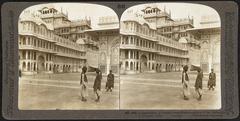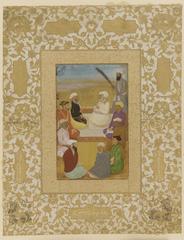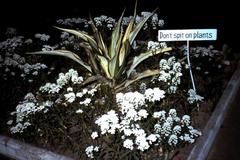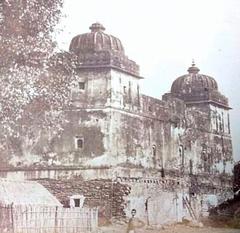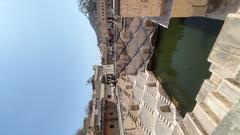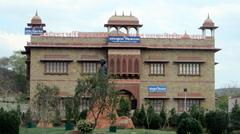Rambagh Palace Jaipur: Visiting Hours, Tickets, and Historical Sites Guide
Date: 15/06/2025
Introduction
Rambagh Palace in Jaipur, Rajasthan, stands as a living testament to India’s royal legacy, seamlessly blending Rajput and Mughal architectural grandeur with a vibrant tradition of hospitality. Originally constructed in 1835 as a modest garden retreat for the wet nurse of Prince Ram Singh II, the palace evolved from a royal hunting lodge to the principal residence of Maharaja Sawai Man Singh II. In 1957, it became India’s first luxury heritage hotel, managed by the Taj Group, an exemplary case of adaptive reuse that preserves both its majestic architecture and living traditions (Rajasthan Places; Wikipedia; Culture and Heritage).
Today, Rambagh Palace draws travelers from around the world, offering guided tours, heritage walks, and immersive cultural events. This detailed guide covers everything you need to know for your visit—including hours, ticketing, accessibility, travel tips, nearby attractions, and more—so you can experience the splendor and history of one of Jaipur’s most celebrated landmarks (Jaipur Stuff; Tripoto).
Table of Contents
- Historical Overview
- Evolution of Rambagh Palace’s Architecture
- Practical Visitor Information
- Visitor Experience and Amenities
- Travel Tips and Nearby Attractions
- Restoration and Preservation
- Notable Architectural Highlights
- Social and Cultural Significance
- Culinary and Wellness Experiences
- Literary and Artistic Legacy
- Community Engagement
- Influence on Heritage Tourism
- Frequently Asked Questions (FAQ)
- Conclusion and Call to Action
- References
Historical Overview
Origins and Early Development
Rambagh Palace began its journey in 1835 as a small garden house for Prince Ram Singh II’s wet nurse, located in what was then a forested area outside Jaipur’s city walls (Rajasthan Places; Travel Setu). Its tranquil location set the stage for future expansions reflecting the tastes and needs of the Jaipur royal family.
Royal Hunting Lodge and Expansion
By 1887, the structure was converted into a royal hunting lodge under Maharaja Sawai Madho Singh II, capitalizing on its secluded setting for noble pursuits (Wikipedia). In the early 20th century, British architect Sir Samuel Swinton Jacob expanded it into a full-fledged palace, introducing Indo-Saracenic elements and a harmonious blend of Rajput and Mughal aesthetics (Optima Travels).
Principal Royal Residence
By 1925, Maharaja Sawai Man Singh II had established Rambagh Palace as his main residence, making it a center of royal hospitality and social life (Rajasthan Places). Lavish renovations and the addition of royal suites and grand halls solidified its reputation as the epicenter of Jaipur’s regal society.
Post-Independence and Adaptive Reuse
Following Indian independence, the maintenance of such estates became challenging. In 1957, Rambagh Palace was transformed into India’s first luxury heritage hotel, an innovative move that both preserved the estate and opened its doors to the world (Culture and Heritage).
Evolution of Rambagh Palace’s Architecture
Rajput and Mughal Fusion
The palace’s architecture masterfully fuses Rajput and Mughal styles. Rajput influences are seen in its grand chhatris (domed pavilions), jharokhas (balconies), and symmetrical courtyards, while Mughal elements are present in the expansive gardens, marble latticework (jalis), and the use of red sandstone and marble (IHCL Fact Sheet; Veena World).
Artistic Features
- Marble Latticework and Carvings: Intricate jalis and sandstone balustrades create a play of light and shadow, while floral and geometric motifs reflect the cultural symbolism of the era.
- Gardens: The 47-acre Mughal and Italianate gardens feature water channels, fountains, and lush lawns, home to peacocks and native flora (Jaipur Tour Guide).
- Interior Décor: Grand halls display Renaissance-inspired décor, crystal chandeliers, and period furnishings, with suites featuring French Empire canopy beds and hand-carved woodwork.
Materials and Construction
Locally sourced sandstone and marble form the backbone of the palace’s structure, with craftsmanship evident in the spiral staircases, ornate ceilings, and lavish interiors (Veena World).
Practical Visitor Information
Visiting Hours
- Non-Resident Visitors: Open daily from 9:00 AM to 5:00 PM for public areas, gardens, and select halls (Jaipur Tourism).
- Guided Tours: Heritage walks and guided tours run between 9:00 AM and 6:00 PM; hours may vary during special events. Advance booking is recommended.
Tickets and Booking
- Indian Citizens: INR 700
- Foreign Nationals: INR 1,500
- Children under 5: Free
- Students/Seniors: Discounts available
- Booking: Tickets available onsite or through the official website. Guided tours and dining reservations should be booked in advance.
Accessibility
Rambagh Palace is wheelchair accessible in most public areas, with ramps and accessible restrooms. Staff are available to assist guests with mobility challenges (IHCL Fact Sheet).
Visitor Experience and Amenities
Accommodation
The palace offers 78 luxury rooms and suites, each exuding royal splendor with modern comforts such as butler service, in-room dining, Wi-Fi, and airport transfers (Optima Travels; HotelsCombined). Room rates range from $653 to $782 USD per night (MakeMyTrip).
Dining
- Suvarna Mahal: Fine Indian dining in a former royal ballroom (HerZindagi).
- Rajput Room: Multi-cuisine menu.
- Verandah Café: Afternoon teas and light snacks.
- Polo Bar: Offers a curated selection of whiskeys and memorabilia from Jaipur’s polo heritage.
Cultural Activities
- Heritage Walks: Guided tours exploring architecture and royal history (Heritage Wedding Jaipur).
- Folk Performances: Traditional music and dance in the courtyards and banquet halls.
- Wellness: Jiva Grande Spa offers Indian therapies, yoga, and royal baths.
Shopping
A boutique shop offers Rajasthani handicrafts, jewelry, and textiles.
Travel Tips and Nearby Attractions
- Best Time to Visit: October–March for pleasant weather (Jaipur Tourism).
- Getting There: 13 km from Jaipur International Airport; 3.1 km from city center. Use taxis, auto-rickshaws, or ride-hailing apps.
- Nearby Sites: Hawa Mahal, City Palace, Amber Fort, Jantar Mantar, and Johri Bazaar.
Restoration and Preservation
Taj Hotels has overseen extensive restoration since 1972, focusing on the conservation of domes, pillars, frescoes, and period furnishings while integrating modern comforts (IHCL Fact Sheet; Jaipur Tour Guide). The palace’s ongoing preservation ensures historical authenticity for future generations.
Notable Architectural Highlights
- Grand Verandahs: Airy spaces for relaxation.
- Chhatris and Cupolas: Iconic domed pavilions.
- Hand-Carved Jalis: Marble latticework with intricate patterns.
- Mughal Gardens: Symmetrical lawns and fountains.
- Historic Suites: Lavish rooms with period décor (Veena World).
Social and Cultural Significance
Rambagh Palace remains a vital center for Jaipur’s cultural life, hosting royal-themed events, weddings, and festivals. Its role as a luxury hotel supports local artisans, musicians, and the broader community, sustaining traditional crafts and performances (Jaipur Stuff; Tripoto).
Culinary and Wellness Experiences
Dining at Rambagh Palace highlights Rajasthan’s culinary heritage, with royal banquets, private garden dinners, and authentic regional cuisine. Wellness experiences include Ayurvedic therapies, yoga, and access to polo grounds and golf courses (Jaipur Stuff).
Literary and Artistic Legacy
Rare books and artifacts document the palace’s history and the lives of Jaipur’s royals. Artworks, antiques, and curated exhibits provide educational and cultural enrichment for guests (Jaipur Stuff).
Community Engagement
Rambagh Palace actively supports local artists and performers, hosting folk musicians, dancers, and artisans, and contributing to the continuity of intangible cultural heritage (Tripoto).
Influence on Heritage Tourism
Rambagh Palace sets a benchmark for heritage tourism and adaptive reuse in India, inspiring the restoration of other palaces and historic sites and driving sustainable economic development (Thrillophilia).
Frequently Asked Questions (FAQ)
Q: What are the Rambagh Palace visiting hours?
A: Open daily from 9:00 AM to 5:00 PM for non-resident visitors.
Q: How can I book tickets?
A: Purchase online via the official website or at the palace entrance.
Q: Are guided tours available?
A: Yes, heritage walks and guided tours are available with prior booking.
Q: Is the palace wheelchair accessible?
A: Most public areas are accessible; assistance is available.
Q: Can I dine at the palace as a non-resident?
A: Yes, but reservations are recommended.
Q: What nearby attractions should I visit?
A: City Palace, Hawa Mahal, Amber Fort, and Jantar Mantar are all close by.
Visuals and Virtual Tours
Explore high-resolution images and virtual tours on the Taj Hotels website and Jaipur tourism portals for a preview of the palace’s grandeur.
Sustainability Initiatives
Rambagh Palace is committed to eco-friendly practices, including water and energy conservation, sustainable waste management, and biodiversity initiatives (Heritage Wedding Jaipur). Guests can participate in and support these efforts during their stay.
Additional Services
- On-site parking
- Currency exchange
- Car hire and travel desk
- Event and wedding planning
- Medical assistance
Conclusion and Call to Action
Rambagh Palace exemplifies Jaipur’s royal traditions, offering a harmonious blend of history, architecture, and modern luxury. Its adaptive reuse as a heritage hotel preserves Rajasthan’s cultural legacy while providing an unforgettable experience for visitors. Whether you’re planning a day tour or a royal stay, Rambagh Palace remains an essential destination for heritage enthusiasts and travelers alike.
Plan your visit, book tickets online, and download the Audiala app for exclusive guides and updates. Follow us on social media to discover more about Jaipur’s timeless wonders.
References
- Rajasthan Places
- Wikipedia
- Culture and Heritage
- Optima Travels
- IHCL Fact Sheet
- Veena World
- Jaipur Stuff
- Tripoto
- Jaipur Tour Guide
- MakeMyTrip
- HotelsCombined
- HerZindagi
- Heritage Wedding Jaipur
- Explore Our India
- Thrillophilia
- Jaipur Tourism

